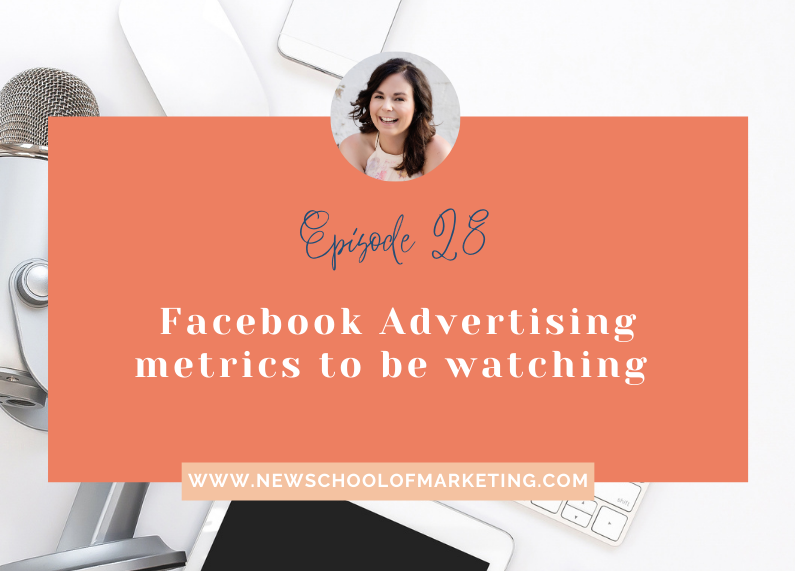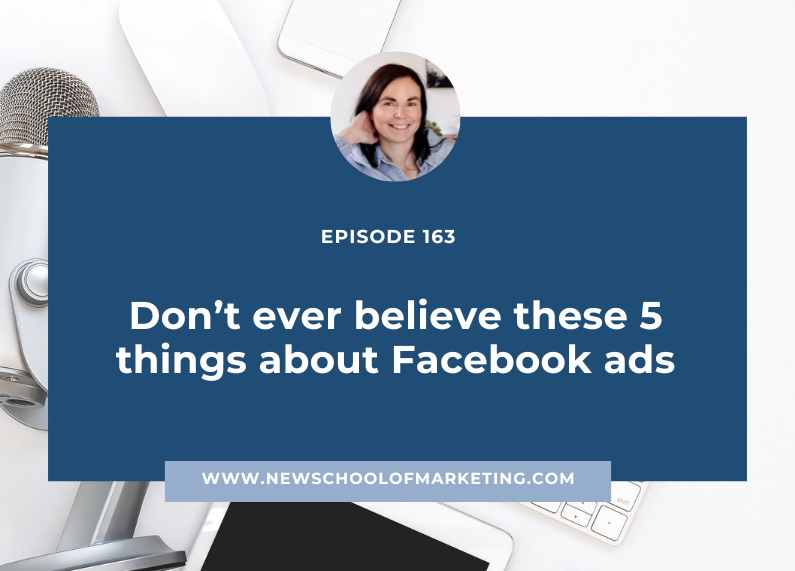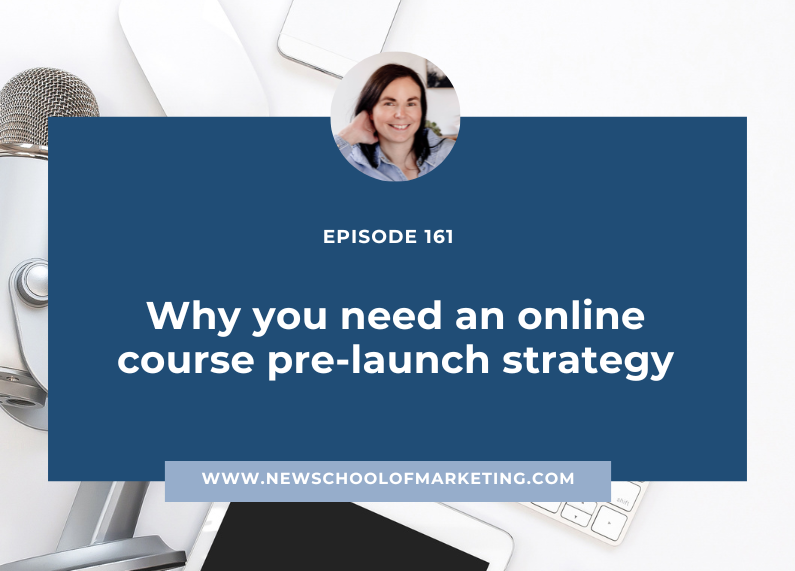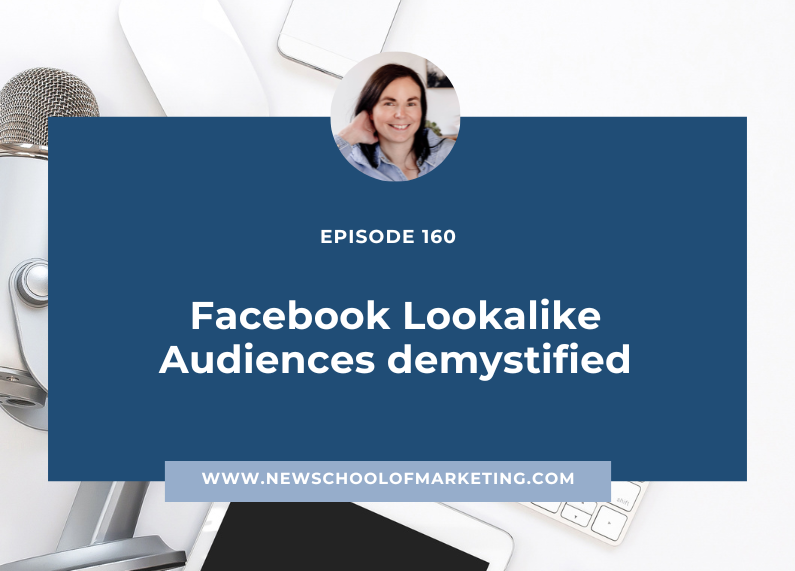
When you start running Facebook and/or Instagram ads you’ll be getting tons of data that you might not quite understand or know what to do with.
So I’d like to talk about which advertising metrics you need to watch.
Of course it all depends on what you’re trying to achieve with your ads and how you have set them up, but we’ll go through a few scenarios that will help you understand your numbers better.
As an ads manager I watch all of the metrics and you should too, but there are a few that I pay close attention to. In this episode I talk about the Facebook ads metrics to be watching for your e-commerce business or your service based business.
Tune in 🎧
Connect with me
Website: www.newschoolofmarketing.com
Facebook: @newschoolofmarketing
Facebook group: @newschoolofmarketing
Instagram: @bianca_mckenzie
Love the New School of Marketing Podcast?
Let’s be honest and upfront, because you know that’s what I’m all about. Podcast reviews are super important to iTunes and the more reviews we receive the more likely iTunes will reward us with better reach.
I want to reach more course creators, store owners and awesome business builders that can add extreme value to our awesome insiders. I already love that you’re here and ready to rock your business, but I’d be extremely grateful if you would review me on iTunes and SUBSCRIBE!
Can’t wait to teach you everything I know about online marketing!
Transcript
Hey, how are you? Thanks so much for tuning into this episode of the New School of Marketing Podcast.
Summer is still in full swing here and school has started again. Not that I really know much about the school year as my little one is still in daycare, but we live right across the gate from a primary school so it’s a little noisier and busier in the mornings and afternoons.
It’s interesting that when it’s noisy I miss the quiet and when it’s quiet I miss the kids’ noise in the background.
It’s probably because my office is in our study and I don’t have the option to shut a door and make it quieter. It’s all part of being a work-from-home business owner I guess.
Something else that’s a part of being a business owner is numbers.
And today I want to talk about Facebook advertising numbers in particular.
When you start running Facebook and/or Instagram ads you’ll be getting tons of data that you might not quite understand or know what to do with.
So I’d like to talk about which advertising metrics you need to watch.
Of course it all depends on what you’re trying to achieve with your ads and how you have set them up, but we’ll go through a few scenarios that will help you understand your numbers better.
Let’s first look at an e-commerce business, so an online store selling physical products.
The first thing you need to know is that Facebook Ads amplify, so whatever is happening in your business can be amplified by Facebook ads.
If you have a business that has been around for a while but isn’t selling anything, you’ll need to find out why this is happening before you dive into Facebook ads.
If you have a business that’s brand new, you can use Facebook ads but you need to know that your first few rounds of ads may not give you a return on ad spend. Instead it will give you data that you can use to improve your store so that you CAN invest confidently in ads that will give you a return on ad spend.
So, now that that’s said, which metrics do you need to be watching once you start advertising?
As an ads manager I watch all of the metrics and you should too, but there are a few that I pay close attention to.
1. Link clicks and CTR (click-through rates)
One of the metrics to be watching are your link clicks together with your click through rate. Your link clicks will be telling you how many people clicked to be taken to the website and link clicks mean that your ads are working because they are interesting enough for people to want to find out more and visit your store. Link clicks alone aren’t enough though, you also want to be looking at the CTR (also called Click Through Rate) which means the percentage of times people saw the ad and performed a link click. In an ideal world, your CTR is at least 1% or higher. If it’s lower you’ll want to revisit your audience targeting or your creative because people aren’t drawn to click on your ad.
2. Adds to cart
Another metric I pay close attention to is the adds to cart. Based on the link clicks I want to know how many adds to cart there were and if this falls within an industry benchmark. There are benchmarks that we monitor and based on the benchmarks we know what an acceptable add to cart rate is but also what an acceptable abandon cart rate would be.
If the numbers fall outside of the benchmarks we look at what’s going on and how we can fix things. For example, if you’re getting a low number of adds to cart but a high number of clicks to the website, it could be that we’re targeting the wrong audience or that the ads don’t give a good idea of what the person clicking might find at the other end.
3. Purchases
The next metric I look at is the number of purchases. It all ties in with the benchmarks and knowing how many adds to cart resulted into purchases. I also look at the number of purchases vs the number of clicks and work out the conversion rate of the ads. I want to see a similar or higher conversion rate as the website shows us. For example in Shopify you get to see what the store’s conversion rate is in the analytics section. I look at the store’s conversion rate over a period of say 3-6 months and ideally it’s over 2% but sometimes that’s not achievable. Anyway, when running ads you’d want to see a similar or ideally higher conversion rate from clicks to purchases.
4. ROAS
If you’ve been researching Facebook ads, you might have come across the term ROAS. ROAS stands for return on ad spend. It’s the equivalent of ROI or return on investment but a term that’s used in the advertising world.
Basically, it means that you are getting money in return for your advertising efforts and in an ideal world, where your ads are working, you’ll see a positive return on ad spend. A return on ad spend of 2x means that for every dollar you spend, you get 2 dollars in return. A return on ad spend of 4x means that for every dollar you spend you get 4 dollars in return etc.
ROAS is different for every business, but obviously the higher the ROAS, the better your returns.
5. Purchase conversion value
The next metric I look at is the purchase conversion value. While the number of purchases is important, it’s more important to know how much money it’s bringing in return. So ROAS shows us how many times the ad spend is returning but the purchase conversion value shows us how many dollars the ads have generated.
6. Purchase conversion rate
I also look at the purchase conversion rate. The purchase conversion rate isn’t a standard metric inside of the Facebook ads manager dashboard but you can set up a custom metric for it.
The conversion rate can be based on a number of things so it’s up to you to determine how you will calculate the conversion. I generally look at the conversion rate from link click to purchase but you could also look at the conversion rate from add to cart to purchase.
It’s a great metric to measure and I’m always thinking of ways to improve conversion for my clients.
So these are the metrics to be watching for e-commerce advertising. I’ll do a quick recap:
- Link clicks and CTR
- Adds to cart
- Purchases
- ROAS
- Purchase conversion value
- Purchase conversion rate
When advertising for a service based business or to sell digital products and courses, the approach is slightly different. You’d ideally be using a funnel to lead someone from getting to know you towards purchasing from you.
Most my course creation clients have funnels with free downloads and/or webinars so we advertise for leads instead of purchases immediately.
In this case we’ll be looking at the following metrics in addition to the previously mentioned metrics.
1. Leads
As I said, for service based businesses and course creators the top of funnel campaigns are often lead generation campaigns. Generally done through offering a freebie or also called a lead magnet and so we look at the number of leads that come in from the advertising campaign.
2. Cost per lead
We also monitor the cost per lead because we want to know how much it is to bring in a lead.
There is a lot of advice on lead costs and how much you should pay or shouldn’t pay, but I’m not going to give you a set number. It entirely depends on your funnel and on your offer.
It’s important to track your cost per lead and measure it against your conversion rate and the price of your offer. The main thing is that you make more money than you spend in the end. So if your offer is $2000 and your conversion rate is 3% it is ok to spend more on a lead than it would be if your offer is $200 and your conversion rate is 1%.
It’s all relative.
3. Lead conversion rate
One more important thing to measure is your conversion rate from click to lead.
Again, there is so much advice out there on what a good conversion rate is for a lead magnet. Most experts say that 20-25% is a good conversion rate, and for some industries it is. For other industries a 60-70% conversion rate is a regular thing.
Again, measure it for your business. Make some tweaks, see if you can improve it.
So that sums up all of the metrics to be monitoring. A quick recap of the additional metrics to be watching if you sell through a funnel.
- Leads
- Cost per lead
- Lead conversion rate
Remember that everything is relative and it all depends on what your business is and what you sell. Do some research into benchmarks in your industry so that you have some idea, but also always strive to get to know your ideal client better so that you can make improvements and run better Facebook ads.
That’s it for this week.








0 Comments